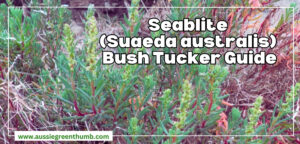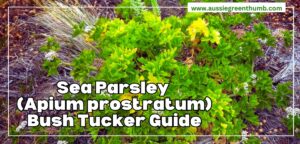Sea grape is a real treat for any garden or landscape thanks to its beauty and fruit. Being drought tolerant and able to handle high salty conditions, makes it hardy and useful.
In our guide to the sea grape, we’ll introduce you to this shrub in more detail, along with the varieties and propagation methods. Once you’ve got your own plant, learn how to best care for it, and its culinary use and health benefits.
More...
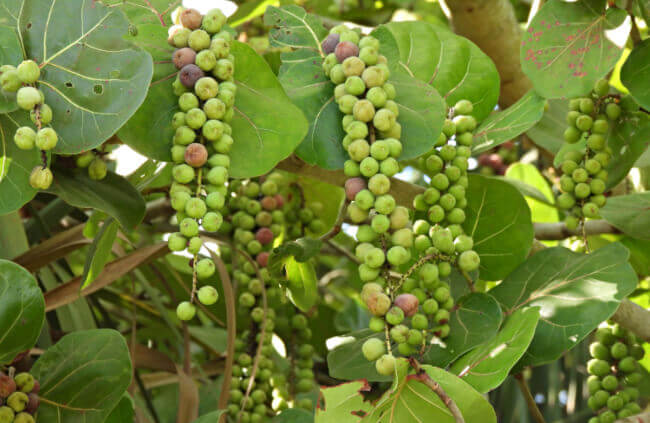
Family: | Polygonaceae |
|---|---|
Genus: | Coccoloba |
Species: | C. uvifera |
Origin: | Florida, Central America, South America, Caribbean |
Common Names: | Sea grape, bay grape |
Location: | Indoor and Outdoor |
Type: | Evergreen shrub |
Growth: | Up to 15 metres tall and 9 metres wide |
Sun requirements: | Full sun, part shade |
Foliage Colour: | Green |
Flower Colour: | White |
Flowering: | Spring and early summer |
Fruit: | Green to reddish purple, around 2 cm, fleshy, resemble grapes, edible, acidic and sweet |
Maintenance level: | Low |
Poisonous for pets: | No |
What are Sea Grapes?
Sea grape is an evergreen shrub that can also be grown as a tree. This depends on where it’s planted and how you prune it. The plant can be used to create a hedge or screen, but also a windbreak.
If you prefer an ornamental look, it can be pruned as a tree which shows off a twisted trunk which is visually interesting. Part of the buckwheat family, sea grape has big leaves that are round, with a leather feel.

Source: IPlantz
Coccoloba uvifera Plant Features
Young plant growth starts off red and the older leaves turn to a bright green complete with red veins. Another distinct feature of sea grape is that its bark is smooth and has a yellow colour.
This shrub grows abundantly in the Caribbean and parts of the United States that are tropical. Sea grapes are used in some areas to help manage erosion of dunes.
Sea grapes produce small, cream flowers in long bunches and these make their appearance during spring and into the start of summer. In some cases, the sea grape blooms throughout the year.
It becomes even more beautiful at the end of summer when the green fruit starts to appear in bunches like grapes. As the fruit ripens during autumn, it becomes a red to purple colour.
Sea grape fruit is salty which speaks to its native growing environment. It’s a mixture of acidity and sweetness which works well as a jam.
Popular Sea Grape Varieties
Coccoloba pubescens (Grandleaf Sea grape)
Grandleaf sea grapes require sandy soil and great drainage along with full sun. If your home is on the beachfront, the plant will do really well, managing drought and high salt content like a pro.
The trunk of the tree can reach a diameter of 60 cm or more with branches that are upright.
Coccoloba diversifolia (Pigeon Sea grape)
Pigeon sea grapes are interesting because the leaves and roots on the younger plants become larger than the leaves of older plants. The tree takes on the shape of a pyramid initially and then starts to spread out.
It has many trunks that look like they are growing alongside each other. It remains small to medium in size.


Get Your Free Guide:
Master Growing Australian Natives eBook
A Must Have Complete Guide for Every Australian Garden
Get Your Free Guide:
Master Growing Australian Natives eBook
A Must Have Complete Guide for Every Australian Garden
Coccoloba rugosa (Red-Flowered Sea grape)
The Red-Flowered sea grape is incredibly rare. It has enormous and thick leaves and is mostly found in certain parts of Puerto Rico. This variety needs 6 to 8 hours of full sun daily.
The tree is small and has a thin trunk, but can reach an impressive height of 10 metres. It produces small crimson flowers, followed by fruit that is oval and red to orange in colour.
How to Grow Sea Grapes in Australia
If you’re considering adding sea grapes to your garden, there are a few requirements to keep it happy. The shrub can’t handle frost or freezing weather. It will need some kind of protection during the cold months.
It can be grown in full sun or part shade and eventually becomes drought tolerant when mature. Salt spray and salty soil is no problem for sea grapes and the shrub is low maintenance. It does however need to be pruned by hand as it doesn’t take kindly to pruning tools.
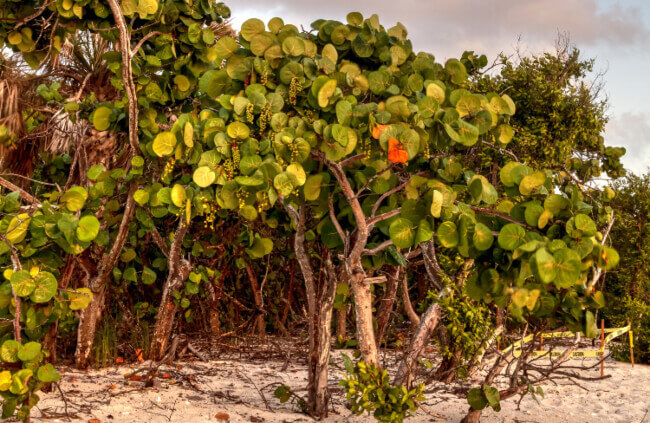
Propagating Sea Grapes
How to Propagate Sea Grapes from Seeds
Sea grapes can grow easily from seed found in the purple to black fruit from an existing tree. You’ll need to clean the seeds and get rid of all remaining fruit before they are planted.
Let the seeds dry out first and you can then plant them in pots filled with an equal mix of compost and sand. Provide a light watering for the seeds and then cover them up using plastic wrap.
The seeds should be kept somewhere warm. Germination usually takes around 3 weeks and once they reach a height of 15 cm they are then ready to be planted outside.
Sea Grapes Propagation from Cuttings
You will need a small plastic container that will allow you to poke holes in the bottom. Fill it halfway with potting soil. The cutting that you take from an existing sea grape tree should be 5 to 10 cm in length.
You can take off all the leaves except those right at the top. Plant the cutting halfway into the soil and then water the soil so that it stays moist. Roots usually start forming within a month.
How to Care for Sea Grapes
Watering Needs
Sea grapes need to be watered if you’re growing it in a pot. When it’s planted in the ground, you don’t really need to water if your area has a tropical climate and enough rain. The shrub becomes drought tolerant once it reaches maturity, but it does respond well to regular water if you want it to grow bushier.
Soil
The sea grape likes sandy soil that is well-draining. Organic mulch is recommended as well.
Humidity
If you are growing your sea grape inside due to cold weather, you can put it in a shallow tray with a single layer of gravel and a bit of water. This creates extra moisture for the tree.
What Fertiliser to Use
A happy and healthy sea grape needs fertiliser. You can use a general liquid fertiliser but we recommend that you use half the strength suggested in the instructions. Feed your sea grapes at least once a month.
You can stop feeding during winter. A water soluble fertiliser added monthly as a spray will also be beneficial.
Pruning Sea Grapes
For sea grape trees that have been around for a few years, you’ll need to prune them during winter. You can cut directly above the part of the branch where it looks raised. Pruning off multiple trunks at the base of the tree will encourage it to grow as a shaded tree with just one trunk.
Any branches that look weak or are dead can be removed, along with any growing at strange angles through the tree. Removing 2.5 to 5 cm off the tips of the branches encourages bushier growth.
We recommend pruning your sea grape at the end of spring or the start of summer if you want to manage its size. This is the way to get the plant to grow as a hedge instead of a tree.
Sea Grapes Culinary Use
The female sea grape plants produce pear shaped fruit which appear once the flowers have bloomed. The fruit remains hard and green for a while and then turns dark purple when it’s eventually ripe.
Sea grape fruit doesn’t all become ripe at the same time which creates a beautiful visual effect of different colours in green, red and purple. When you first bite into the fruit, it is salty and the more you chew, the flavour becomes acidic and sweet.
Sea grape fruit is most popular to create jellies, jams, and a beverage similar to wine. You can opt to eat the fruit raw and the leaves are also edible. They are great in a salad.
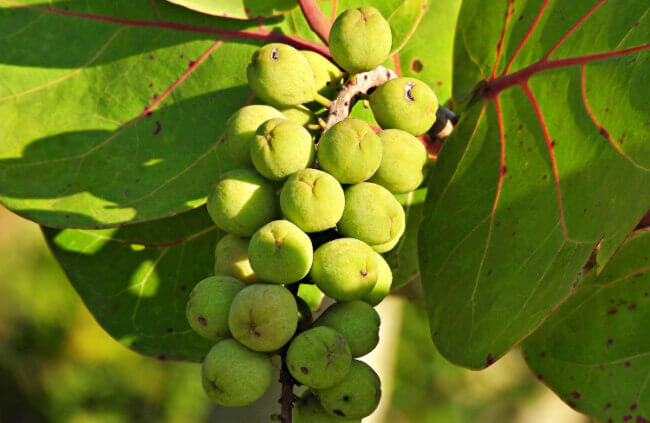
Harvesting and Storing Sea Grapes
When harvesting sea grapes, aim for the fruits that are medium in size and purple. You can run your finger over the grapes and the ones that are ripe will come off quite easily. When preparing sea grapes for eating, you can rinse the fruit under running water for 10 seconds.
To reduce the saltiness, soak the sea grapes in cold water for 5 minutes. The fruit should be stored between 25 and 30°C.
Don’t put them in the fridge or freezer and keep the fruit out of direct sunlight. If you notice that the colour of the fruit turns white, you can put the sea grape under fluorescent light. The normal colour will come back within a few hours.
Health Benefits of Sea Grapes
Sea grapes have many health benefits. They are loaded with vitamins and minerals including vitamin A and C, zinc, calcium and iron. The calcium, fatty acids, and protein in the fruit work well to reduce arthritis and inflammation.
Unsaturated fatty acids are great for improving both eyesight and memory. Sea grape is the friend of heart health, reducing cholesterol and maintaining artery structure. The elasticity of blood vessels are increased, oxidation is prevented, and this protects against cardiovascular disease.
If you’re needing to lower your blood pressure, sea grapes can help. The fruit has vitamin D, calcium and potassium, all of which contribute to a normal blood pressure. The same goes for managing sugar levels in diabetics.
Eating the fruit can help control free radicals which helps to reduce the effects of diabetes.
Speaking for grapes, be sure to check out our detailed guide on how to grow and prune grapevines in Australia.
Coccoloba uvifera Pests and Diseases
Sea grape borer
This pest is usually a light brown to yellow colour. You can manage an infestation by pruning off parts of the plant that are affected.
Aphids
If the leaves of your sea grape look wilted and covered in a sticky substance, or you notice the formation of sooty mould, you are most likely dealing with aphids (mealybugs and whiteflies create a similar problem).
Aphids in particular are soft and pear shaped. You can spray down your plant with water to rinse off the pests and then wipe off the leaves. You could also prune off leaves that are infested. Check out our guide on how to get rid of aphids for more details.
Sea Grapes Frequently Asked Questions
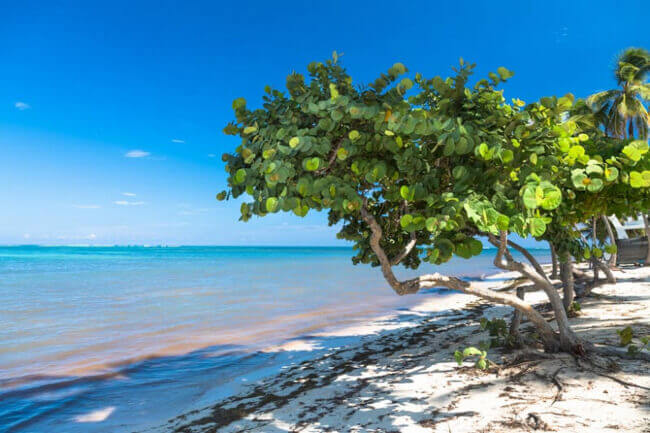
Source: Gardenia
Where does the sea grape get its botanical name from?
Coccoloba comes from the word “cocolobis” which refers to a type of Spanish grape. Uvifera means “bearing grapes” or “like grapes".
Does the sea grape have any interesting historical uses?
The first Spanish colonists would use the thick leaves of fresh sea grape as a type of paper. They could scratch messages onto it using something sharp.
What are some of the other common names of the sea grape?
Sea grape has earned itself many names the world over. These include bay grape, Columbian kino, horse wood, mangrove grape, pigeon wood, platter lead, seaside grape, shore grape, and wild seaside grape.
What are the medicinal properties of sea grapes?
The gum from the bark of the sea grape can be used to treat throat infections and the roots have been used as a treatment for dysentery.
Why is my sea grape not producing fruit?
The most common cause is the location of the plant. Since sea grape is a tropical plant, it needs sufficient light to do well and produce fruit.
Why are there red spots on the leaves of my sea grape?
This sometimes happens due to cold temperatures in the winter time. The plant will be fine as long as it doesn’t become frozen.
Sign up for our newsletter for more plant profiles, gardening advice, and reviews.
A Green Thumbs Up for Sea Grapes
Sea grapes are a welcome helper in coastal areas to stabilise dunes, but are also used as a protective hiding place by small animals. The fruit, with its unique flavour profile, is enjoyed by wildlife and homeowners.
The leaves are simply beautiful with their young red colour palette followed by a brilliant bright green as they age, making sea grapes a welcome garden addition.
Published on July 14, 2023 by Maisie Blevins
Last Updated on February 25, 2024


